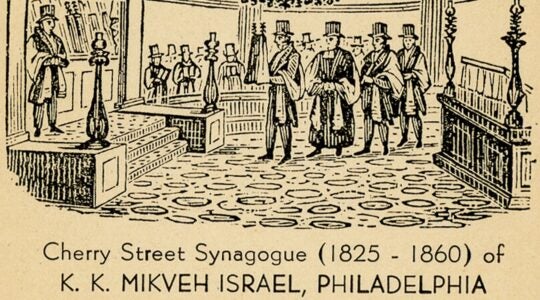“I can’t wait to be sued,” Louisiana’s governor, Jeff Landry, said last week just before signing a law requiring all public schools in the state to “display the Ten Commandments in each classroom” no later than Jan. 1, 2025.
He didn’t have to wait long: On Monday, the ACLU did just that — filed suit on behalf of a wide range of plaintiffs, including several Jewish families, arguing that the new law violated the First Amendment.
The Supreme Court has, in the past, struck down similar laws. But the current legal stakes, for HB71 and similar laws in the works in other states, are far more uncertain. Louisiana’s law will test the Supreme Court’s more recent interpretations of the First Amendment, interpretations that open the door to far more government-sponsored religion than in the past. In this way, the stakes of the case are high and raise the following question: What is the future for the separation of church and state in America?
The First Amendment of the U.S. constitution prohibits government from enacting laws “respecting an establishment of religion.” Thomas Jefferson, in his 1802 Letter to the Danbury Baptists, famously described this constitutional commitment in terms of “building a wall of separation between Church & State.” But figuring out what this constitutional prohibition actually means has been one of the most enduring constitutional questions. What is an “establishment of religion” and what does it mean to keep church and state “separate”?
Starting in the early 1970s, the Supreme Court — at least, more often than not — used a somewhat convoluted and oft-criticized test, known as the Lemon test, to decide when a law violates these principles. Named after the court’s decision in Lemon v. Kurtzman, it required courts to ask three interrelated, if ambiguous, questions to determine whether a law violated the First Amendment: whether a law had a religious purpose, whether a law advanced or inhibited religion, and whether a law was excessively entangled with religion. Check any one of these boxes and the law was struck down.
Over the years, in an attempt to streamline, clarify or maybe just reorient the doctrine, the court sometimes added a gloss to the test, explaining that at the core of all these questions was a concern about endorsing a religion and thereby impermissibly sending the message to other citizens that they were second-class.
Given the sprawling nature of these questions, the Supreme Court — and in turn lower courts — would regularly strike down laws under the Lemon test. Indeed, in 1980 the Supreme Court struck down Kentucky’s attempt to require posting the Ten Commandments in public school classrooms. In 2005, the Supreme Court sounded a more ambivalent tone when addressing two Ten Commandments cases on the same day: It upheld the constitutionality of a Texas Ten Commandments monument that had been long displayed in the state’s capitol, while striking down a new Kentucky law requiring a framed Ten Commandments to be displayed in courthouses and public schools.
The current Supreme Court, however, in its June 2022 decision, Kennedy v. Bremerton, jettisoned the Lemon test and the endorsement gloss on that test. In its place, it has adopted a historical test that focuses on the “original meaning” of the First Amendment’s Establishment Clause as understood by “the Founding Fathers.” And in so doing, the court appears poised to shrink the principle of church-state separation and to rethink — and maybe overturn — past decisions that relied on the Lemon test, including decisions that relied on those principles to invalidate displays of the Ten Commandments in classrooms and courthouses.
So does that mean that Louisiana’s new law requiring the display of the Ten Commandments in public school classrooms is now constitutional? The answer, as expressed in the lawsuit filed challenging the new law, is not so fast — and for two reasons.
First, in its most recent decisions, the current Supreme Court has been clear that government still cannot enact laws that are religiously coercive. Even under a historical test, the founders clearly understood the First Amendment to prohibit religious coercion. And at least in the past, the Supreme Court has construed the concept of religious coercion broadly, to also encompass laws that don’t quite force others to participate in a religious practice. For example, in 1992, the Supreme Court held that a religious prayer at a public school graduation — technically a program where attendance is voluntary — violated principles of church-state separation because it constituted a form of “subtle pressure” on students to attend and participate. As plaintiffs challenging the Louisiana law note, hanging the Ten Commandments in all public school classrooms could also be viewed as generating such subtle forms of coercion on unwilling students.
Second, the court has also previously held that “denominational preference” — that is, enacting laws that prefer one religion over others — also violates the First Amendment. On some accounts, this argument also flows from historical interpretations of the First Amendment. Louisiana’s law could be viewed as violating such a principle in two different ways. As argued by the plaintiffs challenging the law, Louisiana’s law explicitly chooses a version of the Ten Commandments that differs in text and emphasis from the version embraced by various Jewish and Christian denominations. Moreover, the very idea of privileging the Ten Commandments in the classroom might constitute a preference for the Judeo-Christian tradition over and above the traditions of other faith communities.
Of course, whether such arguments will succeed is far from certain given the counterarguments. One can easily see how a court would view the passive display of the Ten Commandments in classrooms as simply not coercive. The display is there, the argument goes, and students are free to ignore it. And the notion that displaying the Ten Commandments impermissibly prefers one religion over others might not work under a test that focuses on how the Founding Fathers understood the First Amendment. For example, the Founding Fathers, in inaugural addresses and Thanksgiving proclamations, did at times demonstrate a willingness to invoke religious language and imagery in their official statements even where it preferred one faith tradition over others.
And it is precisely for this reason that the litigation surrounding Louisiana’s law serves as such an important test case. Now that the Supreme Court has discarded the expansive interpretations of the First Amendment that prohibited such a wide swath of church-state interaction, the big question is what limits remain. What does it mean that government can’t coerce religion? And will the court strike down laws that appear to support the commitments of one faith community over others?
In sum, what does the future hold for the separation of church and state in America? The battle over Louisiana’s Ten Commandments law may provide us with our first glimpse.
JTA has documented Jewish history in real-time for over a century. Keep our journalism strong by joining us in supporting independent, award-winning reporting.







